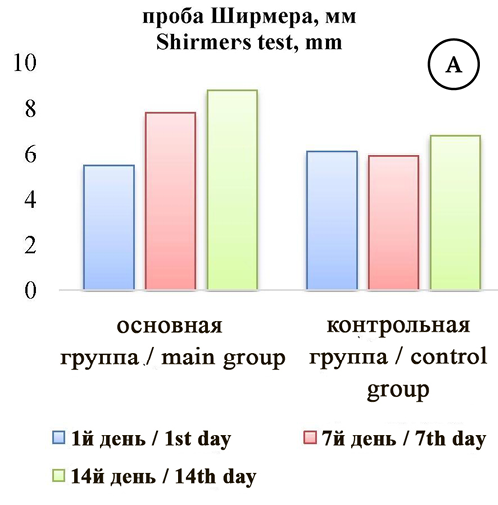EDITORIAL
TO AN ANNIVERSARY OF AN ACADEMIC
Dedicated to the 95th anniversary of professor and Doctor of Medical Sciences Yu. Z. Rosenblum
ORIGINAL ARTICLES
Significance. Results of this randomized, double-masked clinical trial demonstrate the effectiveness of the MiSight soft contact lens in slowing myopia progression over multiple years.
Purpose. The purpose of this study was to quantify the effectiveness of MiSight daily disposable soft contact lens in slowing the progression of juvenile-onset myopia.
Methods. Myopic children (spherical equivalent refraction, −0.75 to −4.00 D; astigmatism, < 1.00 D) aged 8 to 12 years with no prior contact lens experience were enrolled in a 3-year, double-masked, randomized clinical trial at four investigational sites in four countries. Subjects in each group were matched for age, sex, and ethnicity and were randomized to either a MiSight®1 day contact lens (test) or Proclear®1 day (control; omafilcon A) and worn on a daily disposable basis. Primary outcome measures were the change in cycloplegic spherical equivalent refraction and axial length.
Results. Of the subjects enrolled, 75.5% (109/144) completed the clinical trial (53 test, 56 control). Unadjusted change in spherical equivalent refraction was −0.73 D (59%) less in the test group than in the control group (−0.51 ± 0.64 vs. –1.24 ± 0.61 D, P < 0.001). Mean change in axial length was 0.32 mm (52%) less in the test group than in the control group (0.30 ± 0.27 vs. 0.62 ± 0.30 mm, P < 0.001). Changes in spherical equivalent refraction and axial length were highly correlated (r = −0.90, P < .001). Over the course of the study, there were no cases of serious ocular adverse events reported. Four asymptomatic corneal infiltrative (one test, three control) events were observed at scheduled study visits.
Conclusions. Results of this clinical trial demonstrate the effectiveness of the MiSight daily disposable soft contact lens in slowing change in spherical equivalent refraction and axial length.
Introduction. Vision correction by contact lenses is one of the most common and effective methods for correcting refractive errors in children and adults. Compliance with rules of soft contact lenses (SCLs) wearing is one of the most important conditions for a safe use, while violation of compliance is usually the main cause of complications.
Purpose. To study the structure of contact lens wearers by ametropia and lens wearing time as well as to determine the relationship between the incidence of giant papillary conjunctivitis (GPC) with lens wear time and overwear time.
Material and methods. A retrospective analysis of 1 000 records (1 000 patients) of patients who underwent vision correction by SCLs in “Krugozor” ophthalmology clinic in the year 2019 was carried out. Mean age of patients was 24.95 ± 8.62 years. Age, type and degree of ametropia, material (hydrogel, silicone hydrogel or biocompatible hydrogel), lens replacement schedule, presence of complications, lens overwear time and daily wear time were taken into account.
Results. Most SCLs users are patients between 21 and 30 years old (47%) who have a moderate degree of ametropia (52%). Most of them (46%) preferred monthly replacement SCLs, 29% – bi-weekly replacement SCLs, 9% preferred daily replacement lenses, while quarterly replacement lenses were used by 16%. Only 26.9% of SCL users complied with the instructions for lens wear, while for 29.4% of them lens overwear time amounted to up to 14 days, for 34.1% – up to 28 days, and for 9.6% – more than 1 month. More than half (56%) of patients mainly wore SCLs during 16 hours a day, one in five (22.7%) used SCLs during 12 hours a day, and 12.6% – up to 20 hours a day. 8.7% wore lenses during up to 7 days. The incidence of GPC in patients who did not comply with replacement schedule and were overwearing lenses was significantly higher (38.71%) than in patients who followed the replacement schedule (3.21%).
Conclusion. More than half of the users comprised young people with a moderate degree of myopia. The most commonly used SCLs were monthly replacement. It was discovered that only one in four wearers followed recommendations of manufacturers and replaced lenses on time. Lens overwear may lead to a development of a giant papillary conjunctivitis (GPC).
Significance. Prevalence of diabetes mellitus (DM) is increasing worldwide. People with diabetes are at higher risk to dry eye syndrome (DES). The increasing dependence of society on computers, air conditioning, and visual workload, etc. results in an increase in the manifestations of DES in diabetic patients. A significant part of the socially active population with diabetes requires prescription of drugs aimed at correcting disorders associated with both hyperglycemia and dry eyes. Conservative treatment of DES in case of diabetes includes prescription of artificial tears, metabolic, immunocorrecting, hormonal, antiallergic therapies as well as treatment of meibomian gland dysfunction (MGD). The tear substitutes, however, cannot always satisfy the needs of doctors and patients due to the imperfections of their formulas. Therefore, more and more new drugs are introduced to the market that require a comprehensive assessment.
Purpose. To evaluate the clinical efficacy of Keratrop eye drops – a new artificial tear formulation – in dry eye syndrome treatment in patients with diabetes mellitus (DM).
Methods. The study included 65 patients (130 eyes) with dry eye syndrome stages I and II associated with mild and moderate diabetes. These were adult patients of both sexes who had not previously received artificial tears as treatment and were undergoing either inpatient or domiciliary care. All studied patients provided a written informed consent and were divided into 2 groups by random sampling. The main group (35 patients) was receiving Keratrop instillations 2 times a day during 14 days, in the course of antidiabetic treatment. Instillations of “artificial tear” were not prescribed to patients of the control group (30 patients), and they only received antidiabetic treatment prescribed by the endocrinologist. Before and after treatment, all patients underwent standard ophthalmic examinations, meibography imaging, tear film assessment and filled in OSDI questionnaires.
Results. The study showed that during treatment, in patients of the experimental group – with both I and II dry eye syndrome stages – a significant decrease in subjective and objective manifestations was observed, along with an improvement in the tear film stability. In the control group, positive dynamics was observed only in patients with the first stage of dry eye syndrome.
Conclusion. Dry eye syndrome treatment in patients with diabetes should be comprehensive and must include both basic antidiabetic therapy and instillation of tear substitutes.
REVIEWS
Introduction. In modern vitreoretinal surgery, silicone oil is used for replacing the vitreous body during vitrectomy. This surgery is performed to treat retinal detachment, proliferative retinopathy, giant retinal tears and severe eye injuries. In this regard, it seems especially relevant to provide a description of the physical characteristics of silicone oils that determine the choice of surgeons.
Purpose. To study indications for the use of silicone oil tamponade as well as possible complications associated with its use based on a literature review and own research.
Materials and methods. We analyzed literature on PubMed, eLibrary, and Medline over the past 30 years. Overall, 34 sources of literature were reviewed, including results of our own clinical studies.
Results. Literature review has shown that silicone oils are very useful as a permanent tamponade. Although gas tamponade can be used for giant retinal tear management, silicone oils are used for minimizing the risk of post-surgical bleeding and reattach detached retinas in case of severe eye injuries. One of the main issues related to the use of silicone oils is the post-surgical increase in IOP. To reduce the risk of such complication, we have proposed methods of infusion and optimal schedule of silicone oil removal.
Conclusion. Silicone oil is the optimal choice for treating most retinal diseases and improving their prognosis. An important criterion for choice of silicone oil is the time that is required for tamponade.
TECHNOLOGIES
This technology has expanded the possibilities for the comfort and safety of the procedure, reduced the requirements for the thickness of the cornea, and made it extremely comfortable for the patient.
SMILE® method helps improve vision in case of myopia, myopic and mixed astigmatism. The article analyzes the advantages and disadvantages of this technology, its possible risks and side effects.
The data represented in this article was obtained by analyzing scientific publications and practical expertise.
WORKSHOP
The purpose of this guide is to introduce ophthalmologists and optometrists to the basics of fitting of customizable soft contact lenses, which is an important knowledge that enhances practitioners’ skills and helps provide a high visual acuity for many patients.
Material and methods. This guide sets forth the principles of calculation of contact lens parameters, defines parameters specific to customizable lenses as well as assessment of the fit and the rules of lens handling and care.
Conclusions. Following the fitting guide ensures a successful vision correction with customizable soft contact lenses for both doctor and the patient.
DISCUSSION CLUB
LITERARE GUIDE
MEDICINE AND LAW
NEWS: WHAT? WHERE? WHEN?
ISSN 2686-8083 (Online)





































